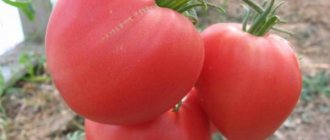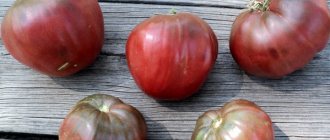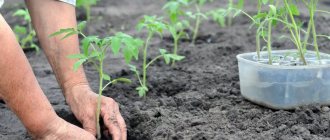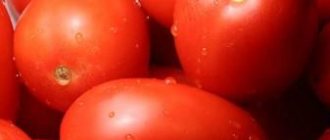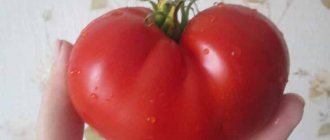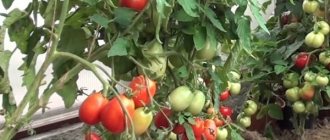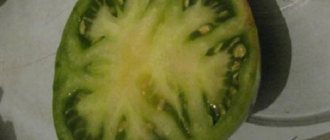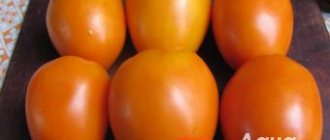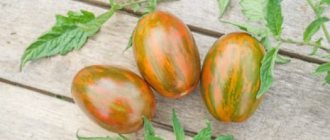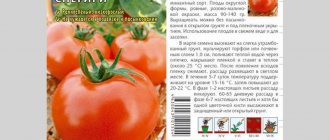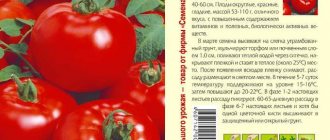Breeding activities are actively moving forward, expanding the diversity of tomato crops and surprising farmers with the latest varieties with interesting properties. Our detailed review of the innovative tomato Buffalo Heart contains characteristics and descriptions of the variety, yield indicators, and photographs of ripe tomatoes.
The variety is distinguished by simple agricultural technology and incredible resistance to diseases of the nightshade family. And reviews from those who planted Buffalo Heart will allow you to be convinced of its merits using real examples.
Description of the variety
The species was bred by Siberian breeders in the 21st century. Its main feature is adaptation to any climatic conditions , which makes it possible to grow it in all regions of our country. Not hybrid. Recommended for cultivation both in greenhouses and in open ground.
The bush is determinate, low-growing. Height up to 80 cm, in greenhouses it grows up to 1 m. The stem is weak, there are few leaves. In terms of ripening, it is classified as mid-season. Fruiting occurs 105 -115 days after the appearance of the first shoots. Summer residents receive ripe tomatoes already in July.
The productivity is high, 4-5 fruits are tied in one brush. From 1 bush you can collect at least 7 kg of vegetables.
Needs stepsoning. The plant is formed into 2 stems.
It is highly resistant to diseases and is practically not susceptible to attacks from infections and pests.
The fruits are large, weight from 500 g to 1 kg. The shape is round-heart-shaped, the color is pink with a raspberry tint. The pulp is dense and juicy. There are few seeds. The peel is smooth and thin. The taste is sweet with a slight sourness.
The harvest is stored for a long time and tolerates long-term transportation well.
In cooking, it is used in a variety of salads, retains its taste in tomato paste, juices, sauces, and ketchups. Not suitable for preservation due to its large size.
Thanks to its presentable appearance, size and excellent transportability, farmers grow tomato crops not only for personal use, but also for sale, which fully reimburses the initial funds spent.
Pictured are Buffalo Heart tomatoes:
Tomatoes Buffalo heart on video
If you grew Buffalo Heart tomatoes, please write whether you liked them or not. What was the yield and taste of the fruits in your climatic conditions? How would you rate the disease resistance of this variety? Briefly describe the advantages and disadvantages (pros and cons) of this tomato. If possible, attach a photo of the entire bush or individual fruits you grew to your comment. Thank you!
Your reviews of the Buffalo Heart tomato and additions to the description will help many gardeners evaluate this variety objectively and decide whether it is worth planting or not.
You can see other interesting varieties and hybrids of tomatoes with photos, descriptions and reviews in our Tomato Catalog. Enjoy watching.
This is a natural variety of tomato. Therefore, we recommend taking seeds from a ripe fruit and using them for planting in subsequent seasons.
How to grow seedlings
Sowing of seeds begins 2 months before planting seedlings in the ground. The soil mixture contains the following components: 2 parts of peat, 1 part of garden soil, 1 part of washed river sand and 0.5 parts of humus with the addition of complex fertilizer with a high content of potassium and phosphorus. The prepared soil is disinfected with boiling water. For looseness, add sphagnum or coconut shavings.
Seeds are sown in a common wooden box or individual containers. Before planting, disinfection is carried out in a weak solution of potassium permanganate for 20 minutes. To improve germination, grains are soaked in a growth stimulator overnight. Afterwards, the dried grains are laid out on a wet cloth and left in a warm place for sprouts to germinate.
Reference! While the seeds are in a wet cloth for 3 days, the temperature is changed sharply: at night the grains are left on the bottom shelf of the refrigerator, and during the day they are again transferred to a warm place. This kind of early hardening will not only increase germination, but will also help to better adapt to street conditions in the near future.
Planting depth is 1 cm. The distance between holes is 3 cm, between rows is 1.5 cm. After sowing, the soil is leveled from above and moistened with a spray bottle. Then cover the containers with film or glass and leave them in a room where the air temperature is at least 23 degrees.
Reference! The Buffalo Heart tomato variety is not a hybrid variety, so you can select the seeds for the next planting yourself.
The first shoots appear 7 days after sowing the seeds. When two true leaves appear on the sprouts, they are picked into separate containers. These can be plastic glasses, peat or seedling pots. The only condition: both boxes and individual containers must have drainage holes.
When the first shoots appear, the seedlings are moved to a lighted place, for example, on a windowsill. The duration of daylight should be at least 12 hours.
Attention! For the first three days, seedlings need round-the-clock lighting.
Water with settled water at room temperature as needed. After picking - once a week, after the appearance of 5 leaves, the number of waterings increases to once every 4 days. The main thing is to ensure that the soil does not become waterlogged.
After 2 weeks, the sprouts are fed for the first time with complex fertilizer, for example: “Master”, “Agricola”.
2 weeks before planting in a permanent place, the seedlings begin to harden. Despite the fact that the culture was created in the harsh northern region, the seedlings look weak. Those who sow seeds of this species for the first time initially think that the seedlings have failed or are sick. But don’t be afraid of the appearance of the seedlings. Oddly enough, but soon the young bushes grow stronger and successfully survive in any weather conditions.
The hardening process boils down to keeping the seedlings in the open air, starting from 2-3 hours and gradually increasing to 1 day. In this case, the night temperature of the room where the seedlings are brought overnight should drop to 14 C.
Diseases and pests
This variety of tomatoes is practically not susceptible to diseases, and in order to protect the garden from pests, preventive treatments with insecticidal preparations should be carried out.
The unique combination of short stature and large fruit makes the Buffalo Heart tomato variety so popular among vegetable growers who grow it both for their own consumption and for sale.
| Early ripening | Mid-late | Mid-early |
| Garden Pearl | gold fish | Em Champion |
| Hurricane | Raspberry miracle | Sultan |
| Red Red | Miracle of the market | A lazy man's dream |
| Volgograd Pink | De Barao Black | New from Transnistria |
| Elena | De Barao Orange | Giant Red |
| May rose | De Barao Red | Russian soul |
| Super prize | Honey fireworks | Bullet |
If you find an error, please select a piece of text and press Ctrl+Enter.
How to grow tomatoes
After 2 months, when the height of the sprouts is at least 30 cm and they have 7-8 leaves, they are ready for transplanting. And again, there is no need to be alarmed that the seedlings are tall, long and seemingly unhealthy. Once you transplant them into open ground, they will begin to strengthen.
Transplant seedlings into the ground after the threat of the last frost, when warm weather sets in. Basically, this is the middle - end of May.
The culture loves loamy soil, pre-fed with organic matter or minerals. Planting scheme: 3-4 seedlings per 1 sq. m. The holes are well watered and sprinkled with ash.
Until the ovaries, water 2 times a week with a small amount of settled water. During fruit ripening, water more often and more abundantly. Water at the root, otherwise the likelihood of fungal infections increases. Overmoistening of the soil negatively affects the taste of tomatoes; they become watery.
To keep moisture in the soil longer, the beds are mulched.
From day 10, young bushes begin to be fed regularly. During the period of growth and development of bushes, nitrogen fertilizers are used as top dressing. They promote healthy growth and green growth. During flowering and ovaries, fertilizers are changed to potassium and phosphorus.
Organic matter - bird droppings or mullein infusion - is considered a universal fertilizer: it contains all the necessary nutrients. Organic fertilizers are good for plants throughout the growing season.
After watering, it is necessary to loosen and remove weeds with roots. Loosening helps warm the earth and saturate it with oxygen. Hilling up the bushes helps oxygen penetrate to the roots, which has a beneficial effect on the growth and development of the bush.
Culture requires mandatory stepsoning. It is recommended to keep bushes with 2 stems. This means that all side brushes are removed. In this case, nutrients are spent on the formation and mass of the vegetable, and not on the growth of unnecessary branches. Stepping is carried out once every 10 days.
Despite the fact that the species is short, gartering of the wrists is required. Which is not surprising, considering the mass of fruit. The garter is tied to wooden stakes installed next to the plants.
Diseases and pests
The vegetable crop has proven itself to be unusually resistant to diseases characteristic of the nightshade family. It is also resistant to attacks from insect pests. Therefore, it remains only to briefly mention the necessary preventive measures in the event of a massive pest invasion. And fungal spores can take completely unprotected plants by surprise. Preventive measures are a kind of barrier, an obstacle to infection.
Fitosporin is a good barrier against late blight. It will not protect the plant from disease, but it will also destroy the cause of the disease. Alternative options are “Quadris” or “Revus”.
There are many traditional methods for parasites that are no less effective than treatment with insecticides. For example, tobacco dust, which is used to cover the beds, repels insects. Treating the stems with a soap solution works well against aphids. Spraying with a weak solution of vinegar repels insects with a pungent odor, as does planting fragrant herbs next to tomatoes.
Sowing seeds for seedlings
To be confident in the future harvest, it is best not to buy seedlings, but to grow them yourself. Since “buffalo heart” is not a hybrid, seeds for planting do not need to be purchased every year; they can be collected from tomatoes grown by yourself. Judging by the reviews of experienced gardeners, their own seeds have even better germination than purchased ones. Regardless of whether the seeds are bought in a store or collected from your own fruits, they are sown according to the same pattern.
The soil
The choice of soil for sowing must be taken seriously. It should be nutritious and loose. If you buy a special substrate for tomatoes, you can be sure of its balanced composition. If you prepare the soil yourself, it must meet the following requirements:
- composition: peat, soil from the garden, sand and humus in a ratio of 2:1:1:0.5, with the addition of complex fertilizer (with a high content of phosphorus and potassium and a minimum of nitrogen);
- the prepared soil should be disinfected: steamed in a double boiler a week before sowing;
- the earth mixture should be loose, allow air to pass through and absorb water well: add soil disintegrants (sphagnum, vermiculite or coconut).
Deadlines
Seeds need to be sown 60 - 70 days before planting seedlings in open or closed ground. If sowing is carried out in March, then the harvest of greenhouse “hearts” can be harvested as early as June. For an open area, the seeds are sown a little later. Approximately 7 days after sowing, the first shoots should appear. When the sprouts have 2 true leaves, they need to be picked separately.
Tomato variety "Polfast F1": description, characteristics, sowing seedlings, fertilizing, yield, photos, videos and the most common tomato diseases
Growing container
To grow tomatoes you will need two types of containers:
- for sowing seeds before picking: special or homemade boxes, trays, cassettes, the height of the walls is 8 - 10 cm;
- for pickled seedlings: disposable plastic cups, seedling pots, peat pots, the size of which is at least 12 x 17.
Seed preparation
The germination of seeds depends on their quality. If you buy seeds from a reliable manufacturer, they should already be completely ready for planting. Seeds of dubious origin and those collected from your own garden must be prepared for sowing. Usually several preparatory stages are carried out:
- culling: only undamaged seeds of the correct shape and the same color are selected. They are lowered into a bowl with salted water; specimens suitable for sowing sink to the bottom;
- disinfection in one of the disinfecting solutions for 20 minutes: potassium permanganate (pink solution), hydrogen peroxide (2% warm solution) or aloe juice (50% aqueous solution);
- soaking in growth-stimulating nutrients overnight (Epin, Immunocytofit, Virtan-Micro, potato juice, aloe juice are suitable);
- germination: spread the seeds soaked in a growth stimulant or simply in water on a wet cloth and place in a warm place until the sprouts hatch;
- hardening: change the temperature sharply within 3 days (put it on the bottom shelf of the refrigerator at night, and again in a warm place for the day).
Sowing seeds
A box or other container for sowing seeds is filled with pre-disinfected substrate and moistened. Seeds are sown according to the following scheme:
- groove depth: 1 – 1.5 cm;
- distance between furrows: 3 – 4 cm;
- distance between seeds in a row: 1.5 – 2 cm.
Seedling care
Before planting seedlings in a permanent place, they need careful care. She needs the right conditions:
- The location does not matter until seedlings appear. The main thing is to be warm. When they hatch, it is advisable to place the box on a bright windowsill.
- Temperature: seedlings are comfortable at +22°C during the day and at +16°C or +18°C at night.
- Lighting is required for 12 hours a day. If there is no sunny windowsill, you can use phytolamps, which should hang at a distance of 50 cm from the seedlings. For the first 3 days after germination, it is advisable to illuminate the seedlings around the clock.
- You need to water with settled water at room temperature as the soil dries. Only peaked sprouts need watering once every 7 days. And when they have 5 leaves, water them once every 4 days. You need to moisten the soil, but not the bush.
- You can feed 2-week-old seedlings with a weak solution of complex fertilizers (this includes Agricola, Plantafol, Master) no more than once every 10 days.
Hardening of seedlings
A few weeks before planting seedlings in the garden (at least 2 weeks), you need to start hardening them. This can be done by taking the container with young tomatoes out into the fresh air (on the balcony, in the yard in a shaded place). Gradually, the duration of the procedures should increase. Hardened plants experience less stress from replanting, take root faster in a new location and are not susceptible to disease.
The nuances of growing in open ground and in a greenhouse
The species adapts equally well to both field and greenhouse conditions. The choice of planting site is influenced by the climatic features of the region.
In a greenhouse, the growth of determinate bushes will be higher than outside. Here their height can reach 1.2-1.8 m. If necessary, pinching the crown of the plant is done, which determines the final growth point.
Plants are planted in the greenhouse 2-3 weeks earlier, which makes it possible to pick the first ripened vegetables already in June.
Remember to regularly ventilate closed spaces. This protects plants from fungal diseases and insect pests.
All tomatoes love moderately sunny places, protected from strong winds. Accordingly, open beds should not be ventilated. However, a light southern breeze blowing through the beds will protect them from pathogenic fungi and promote pollination.
Features of cultivation
This variety is planted in the soil as seedlings. Seeds are sown 60 days before transplanting into the ground. The substrate for seedlings is loose and fertile. When the seedlings grow to two true leaves, they are planted in individual containers. Plants can be moved into the soil or greenhouse at the moment of formation of 4-5 true leaves.
It is important to harden off the plants before transplanting. To do this, they are placed on the balcony, first for 1 hour, then the time spent outside is increased to 24 hours. When planting in the garden, the plants are placed freely - no more than 4 bushes per 1 square meter. m. To increase productivity, apply special fertilizer for tomatoes. The bushes need moderate watering and loose soil without weeds.
Important! Bushes need to be pinched in a timely manner.
Harvesting and application
The first ripened vegetables occur in the middle - end of July, and, thanks to extended fruiting, the collection of ripe vegetables continues until the end of summer. Picking large tomatoes from tied bunches is not difficult. But if the branches are not tied up, the fruits will have to be picked up from the ground along with the broken branches.
Since the crop belongs to the salad family, its best culinary use is in fresh salads. Tomatoes are also fried with scrambled eggs and baked with meat. It is when used fresh that vegetables reveal their full range of flavors.
Due to their large size, vegetables are not used for canning, but they are quite suitable for processing for winter preparations. Among tomato products, the juice is especially noteworthy, thick and tasty, where tomatoes best retain their gastronomic properties. Lecho, ketchup and adjika are also made from the fruits.
Vegetables can be stored for a long time and retain their appearance well during long-term transportation. These qualities allow them to be used for commercial purposes, which is of great importance for entrepreneurial farmers. Other advantages for commerce are the high fruiting rate and the large weight of vegetables.
Productivity
Approximately 10 kg of selected tomato fruits are collected from each plant.
Which regions are best to grow in?
The tomato variety “Buffalo Heart” can be grown in all regions of the Russian Federation. There are no special recommendations for choosing a region. Tomato grows well in both northern and southern regions. Due to its versatility, the variety can be cultivated both in greenhouses and in unprotected soil.
A characteristic feature of the tomato variety “Buffalo Heart” is its extended fruiting. Thanks to this, the tomato will become an excellent variety for owners of household plots growing tomato crops for sale.
The tomato variety “Buffalo Heart” is not afraid of common tomato diseases and insect pests. Therefore, the variety will be of interest not only to experienced vegetable growers, but also to beginning gardeners.
Did the article help you?
Already helped 0 times
There are many tomato varieties and hybrids on the seed market with different characteristics,
Tomatoes “Pink Icicle” are a new variety, but quickly gained great popularity among summer residents and
Number of blocks: 18 | Total number of characters: 18666Number of donors used: 8Information for each donor:
- https://sovrusadba.ru/ogorod/ovoshhi/pomidoryi/tomat-serdtse-buyvola.html: 1 out of 2 blocks used, number of characters 1449 (8%)
- https://tomatland.ru/catalog/259: 2 blocks out of 5 were used, number of characters 2608 (14%)
- https://sveklon.ru/tomat-serdtse-bujvola: 2 blocks out of 7 used, number of characters 1053 (6%)
- https://MoeFermerstvo.ru/tomat/uborka/serdtse-bujvola: 1 blocks out of 3 used, number of characters 2184 (12%)
- https://DachaMechty.ru/tomat/sort/serdtse-bujvola.html: 1 blocks out of 3 used, number of characters 1619 (9%)
- https://web-selo.ru/sort-pomidora-serdtse-bujvola-foto-otzyvy-opisanie-harakteristika-urozhajnost.html: 3 blocks out of 9 used, number of characters 2577 (14%)
- https://rusfermer.net/ogorod/plodovye-ovoshhi/tomat-pomidor/srednespelye-sorta/serdtse-bujvola.html: 2 blocks out of 6 used, number of characters 1677 (9%)
- https://agronom.expert/posadka/ogorod/paslenovye/tomat/serdtse-buyvola.html: 3 blocks out of 8 were used, number of characters 5499 (29%)
Source: alt-zem.org
Advantages and disadvantages of the variety
The following advantages can be of interest to many tomato lovers who want to receive high-quality tomatoes that do not require complex care:
- high level of adaptation in all regions;
- ability to tolerate short-term drought and cold snap;
- high resistance to diseases;
- ease of care;
- low growing bush;
- extended fruiting period;
- high quantitative and qualitative indicators;
- large fruits;
- excellent taste;
- long-term storage of ripe vegetables;
- excellent transportability;
- the ability to independently select seeds for planting.
A few minor disadvantages of this type:
- weak seedlings;
- Garter required;
- stepsoning required;
- impossibility of use for whole-fruit canning.
Growing early ripening tomato varieties
Growing tomato seedlings of different ripening periods does not have any significant differences, except for the timing of planting seeds for seedlings and planting seedlings.
Planting seeds for seedlings:
- Calculation of the date of planting seeds: subtract the growing season (85-100 days) and 5-6 days for seed germination from the expected date of planting seedlings in a greenhouse or soil.
- Check the seeds, select healthy ones, of the correct shape (remove crooked and small ones), soak for 20-25 minutes in a light pink solution of potassium permanganate, rinse under running water, spread on a damp cloth in one layer and put in a bag, which is placed in a warm place (23°-25°). Remove the bag after sprouts appear.
- Plant the sprouted seeds in a seedling box with prepared and disinfected soil (peat, humus, turf soil in equal parts with the addition of 1 teaspoon of potassium sulfate, superphosphate and urea per 10 liters of soil).
- Maintain the temperature at 23°-24°, reducing it by one or two degrees after a month. Seven days before planting, reduce the temperature to 19°, moving the boxes to the balcony, veranda, opening windows (no drafts).
Seedling care:
- Pick when 1-2 leaves appear.
- Seven days after picking, feed the seedlings with an infusion of humus (1 part in ten parts of water). Seven days after the first feeding, carry out the second (you can buy a ready-made mixture for seedlings and prepare it according to the instructions).
- Water regularly, without excessive waterlogging (too much moisture leads to stretching of the plant).
Transplanting:
- When 8-10 leaves and one flower cluster are formed, the seedlings are planted in a greenhouse (soil).
- Cabbage and cucumbers are good predecessors for tomatoes; potatoes cannot be planted after nightshades. An undesirable neighbor of tomatoes is potatoes (common pathogens).
- After onions and root vegetables, during autumn digging, be sure to add organic matter (compost, humus - about a bucket), superphosphate and potassium sulfate (2 tbsp and 1 tbsp per 1 m²).
- Add organic matter (1/2 liter), potassium sulfate and urea (1 tsp each), superphosphate (2 tsp) to the wells.
- Maintain a distance of 50-55cm between bushes and 70cm between furrows.
- Water the planted plants well, cover the soil with mulch, and leave them undisturbed for 7-10 days.
- After rooting the seedlings, tie the stems to trellises and stakes.
- Further care:
- Watering should be carried out when the soil, taken from a depth of 10-15 cm, does not form a lump when compressed, but crumbles. Keep the soil in a state of moderate moisture.
- For indeterminate tomatoes, watering is not reduced during fruit ripening - the ovaries are constantly forming.
- Infusions for feeding: one part mullein to ten parts water or one part chicken manure to twenty parts water.
- 1st feeding: 10-12 days after planting in the ground with an infusion of organic matter (1 liter per 10 liters of water) and mineral fertilizers for this growing season. Apply fertilizer during watering. Mulch the soil (humus, compost).
2nd feeding: beginning of fruit set. Two liters of solution (10 liters of organic infusion and a tablespoon of ready-made fertilizer) are applied under each bush.
3rd feeding: 2.5 liters of the same composition per bush at the beginning of fruit harvesting.
- Remove the stepsons, leaving 1-2 lower ones to form stems. It is better to cut in dry, sunny weather (the cut area dries out faster).
Farmer reviews
Of course, many gardeners are satisfied with large harvests with minimal effort. You don’t even need to dream of anything better: planted, watered, fed and after 2 months - excellent healthy offspring. One tomato is enough for a salad or a main course. And you don’t need to worry if for some reason you can’t water your tomato crop on time on a hot summer day. She will calmly endure such a misunderstanding, preserving the external and taste qualities of her fruits.
Pavel, Kemerovo: “Excellent tomatoes. I grow it in open ground year after year. Even if the summer is not warm enough, you can get a lot of vegetables. The very first ones are the largest. There are 4-5 pieces in a brush. The main advantage for me is that I collect the seeds myself for next year.”
Olga, Lipetsk region: “I grew it under film and sowed it in February. The vegetables ripened in early June, tasty and large. Compared to other varieties sown at the same time, they turned out to be the earliest. The result was impressive, I will plant again.”
Planting and care
Use light fertile soil. It is ideal to use a ready-made mixture, or prepare it yourself. Optimal composition:
- 2 parts garden turf;
- 1 part peat;
- 1 part compost;
- 1 part sand;
- 1 glass of ash.
Chemical elements are added to 10 kg of soil - 20 g of superphosphate and 5 g of potassium sulfate.
The soil is moistened, the seeds are planted to a depth of 1-2 cm. A thin layer of finely dispersed substrate is sprinkled on top.
Nuances of care:
- Irrigation with warm water.
- Feed 1-2 times a month.
- Picking with 2-3 true leaves.
- Additional lighting with phytolamp.
Characteristics of this varietal variety
The description of this variety should begin with the size of the fruit. They are truly huge: the weight of one fruit can vary from 500 grams to 1 kg. The taste of Buffalo Heart tomatoes is excellent: they are characterized by a special meatiness and sweetness.
This variety is unique; the huge size of the fruit is successfully combined with the short stature of the bush. The weight of one fruit can reach 1 kg, and the size of the bush reaches only 80 - 100 cm.
In terms of ripening time, this variety is a mid-season variety. The harvest begins 100-115 days after planting. This variety is not a hybrid; there are also no F1 hybrids of the same name. The characteristics of this tomato indicate the acceptability of its cultivation both in a greenhouse and in open ground.
The fruits are round and shaped like a heart. Very fleshy, with a small amount of seeds. The fruits are pink with a raspberry tint. Another advantage of this type is the excellent transportation capabilities of tomatoes and their long shelf life.
The yield of the variety is very high; up to 10 kg of tasty fleshy fruits are harvested from one bush per season. These tomatoes are ideal for fresh consumption: various salads, stewed, fried and boiled dishes are prepared from them. They make very tasty tomato juice, ketchup, and sauce. But it won’t be possible to roll a sweet tomato into a jar for the winter due to its large size.
Tomato Dwarf Lemon Ice
Medium late variety (fruits are formed on the 120-130th day after emergence) of American selection.
The plants are medium- and low-growing (up to 1 m), compact, require tying to a support and partial pinching. Can be grown as a standard. The leaves are wide and wrinkled.
Does not tolerate shading and requires nutritious soil. Productivity is high.
The fruits are medium-sized (weight up to 200 g), heart-shaped, lemon-yellow “transparent” in color. The skin is shiny, thin, the flesh is fleshy, dense, aromatic. The taste is well balanced, pleasant, sweet with citrus notes.
The fruits are characterized by good keeping quality and transportability.
In general, a lot of heart-shaped tomatoes have been bred; we have not listed all the most popular ones. Most of these varieties, you understand, have the word “heart” in the name - Red Butter Heart, Heart of Ashgabat, Eagle Heart, Kangaroo Heart, Rusted Heart of Everett, Heart of Bangladesh, Buffalo Heart, Angelina Heart, Zebra Heart, Desdemona Heart, Pink Heart , Serbian Heart, Golden Heart... There are variations “on the theme” - Heart Kiss, Heartbreaker, Heart-Shaped Striped, Very Hearty... There are much fewer original names - Yasha Yugoslavian, African Viking, Koenigsberg, Shirley, Siberian Garden, Favorite Holiday, Twins, Honey Spas , Pink Dream, King of London, Sugar Buffalo...
